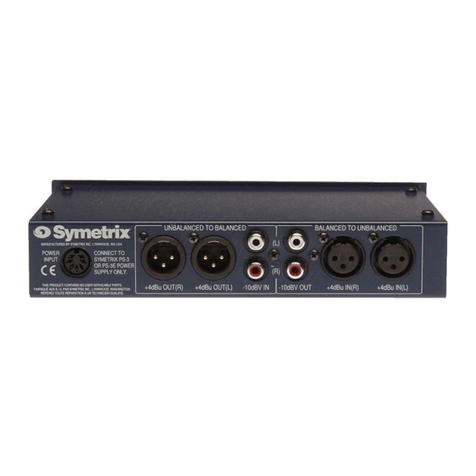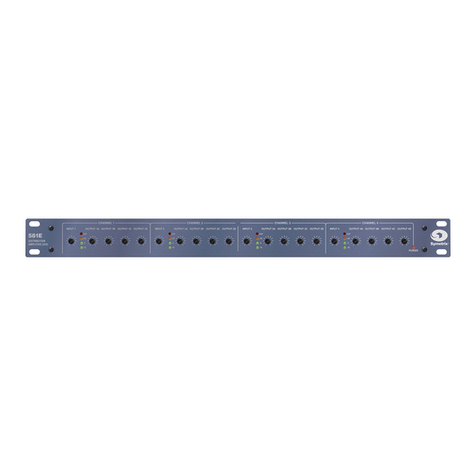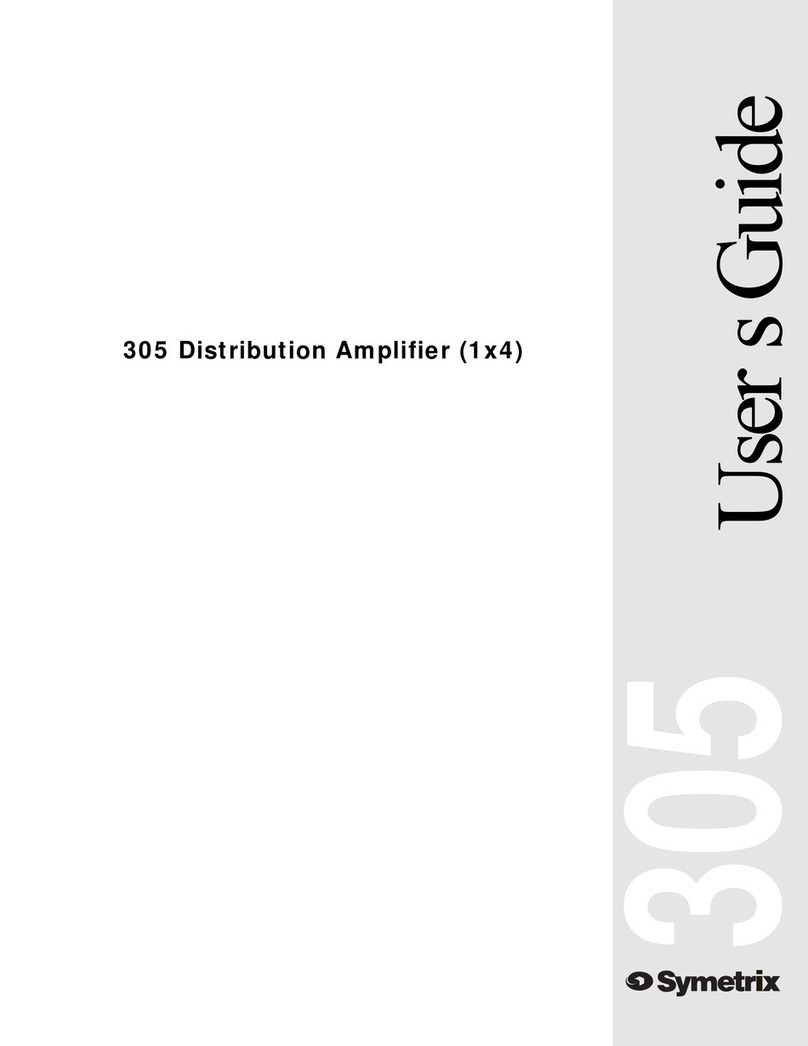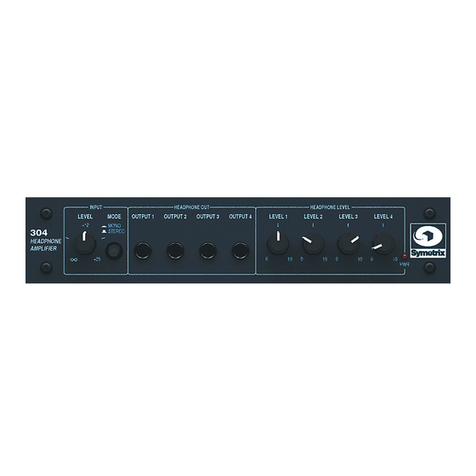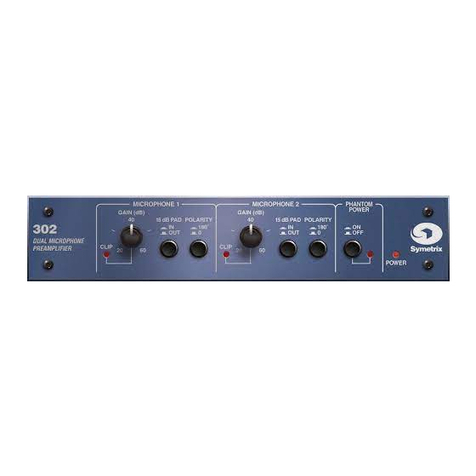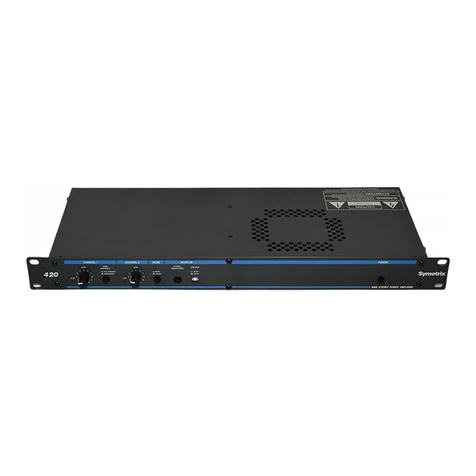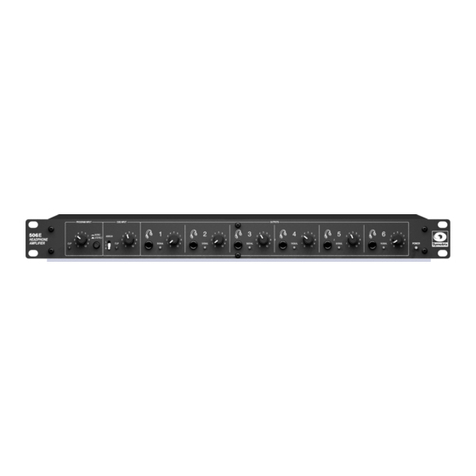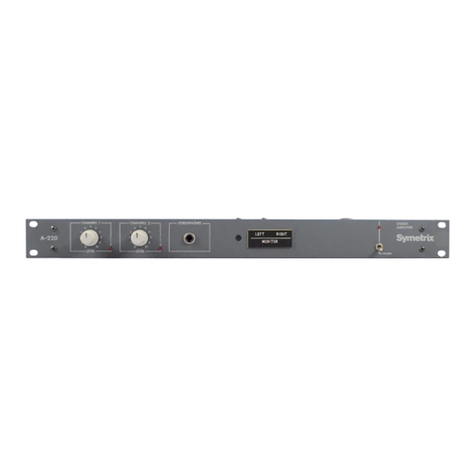
User’s Guide
581E Distribution
Amplifier
1/11
Before You Begin
What Ships in the Box
RA 581E hardware unit.
RA detachable power cord.
RThis User’s Guide.
Getting Help
If you have questions beyond the scope
of this User’s Guide or the help module,
contact our Customer Support Group in
the following ways:
Tel (425) 778-7728
8:00 am to 4:30 pm
Monday through Friday,
Pacific Time
Web support.symetrixaudio.com
Important Safety Instructions.
1. Read these instructions.
2. Keep these instructions.
3. Heed all warnings.
4. Follow all instructions.
5. Do not use this apparatus near
water. This apparatus shall not be
exposed to dripping or splashing and
no objects filled with liquids, such as
vases, shall be placed on the appara-
tus.
6. Clean only with dry cloth.
7. Do not block any ventilation open-
ings. Install only in accordance with
the manufacturer’s instructions.
8. Do not install near any heat sources
such as radiators, heat registers,
stoves, or other apparatus (including
amplifiers) that produce heat.
9. This apparatus shall be connected
to a mains socket outlet with a
protective earthing connection. Do
not defeat the safety purpose of the
polarized or grounding-type plug. A
polarized plug has two blades with
one wider than the other. A grounding
type plug has two blades and a third
grounding prong. The wide blade or
the third prong are provided for your
safety. If the provided plug does not
fit into your outlet, consult an electri-
cian for replacement of the obsolete
outlet.
10.Protect the power cord from being
walked on or pinched particularly at
plugs, convenience receptacles, and
the point where they exit from the
apparatus.
11. Only use attachments/accessories
specified by the manufacturer.
12.Use only with the cart,
stand, tripod, bracket,
or table specified by
the manufacturer, or
sold with the apparatus.
When a cart is used, use caution
when moving the cart/apparatus com-
bination to avoid injury from tip-over.
13.Unplug this apparatus during light-
ning storms or when unused for long
periods of time.
14.Refer all servicing to qualified service
personnel. Servicing is required when
the apparatus has been damaged in
any way, such as power-supply cord
or plug cord is damaged, liquid has
been spilled or objects have fallen
into the apparatus, the apparatus has
been exposed to rain or moisture,
does not operate normally, or has
been dropped.
AVIS:
NE PAS OUVRIR
Il ne se trouve a l’interieur aucune piece pourvant entre reparée l’usager.
SEE OWNERS MANUAL. VOIR CAHIER D’INSTRUCTIONS.
S’adresser a un reparateur compétent.
RISQUE DE CHOC ELECTRIQUE
No user serviceable parts inside. Refer servicing to qualified service personnel.
CAUTION
WARNING:
TO REDUCE THE RISK OF FIRE OR
ELECTRIC SHOCK DO NOT EXPOSE
THIS EQUIPMENT TO RAIN OR MOISTURE
DO NOT OPEN
RISK OF ELECTRIC SHOCK
The lightning flash with arrowhead
symbol within an equilateral triangle is
intended to alert the user of the pres-
ence of uninsulated “dangerous voltage”
within the product’s enclosure that may
be of sufficient magnitude to constitute
a risk of electric shock to persons. The
exclamation point within an equilateral
triangle is intended to alert the user of
the presence of important operating and
maintenance (servicing) instructions in
the literature accompanying the product
(i.e. this User’s Guide).
CAUTION To prevent electric shock,
do not use the polarized plug supplied
with the unit with any extension cord,
receptacle, or other outlet unless the
prongs can be fully inserted.
Power Source. The 581E Distri-
bution Amplifier hardware is configured
at the factory for domestic or export
markets. Ensure that your AC mains
voltage matches that of your power
supply. Refer to rear panel marking for
correct AC source voltage. Use only the
power cord and connector specified for
the product and your operating locale.
A protective ground connection, by way
of the grounding conductor in the power
cord, is essential for safe operation. The
appliance inlet and coupler shall remain
readily operable once the apparatus has
been installed.
User Serviceable Parts. There
are no user serviceable parts inside the
581E Distribution Amplifier. In case of
failure, customers inside the U.S. should
refer all servicing to the Symetrix factory.
Customers outside the U.S. should refer
all servicing to an authorized Symetrix
distributor. Distributor contact information
is available online at
www.symetrixaudio.com.
